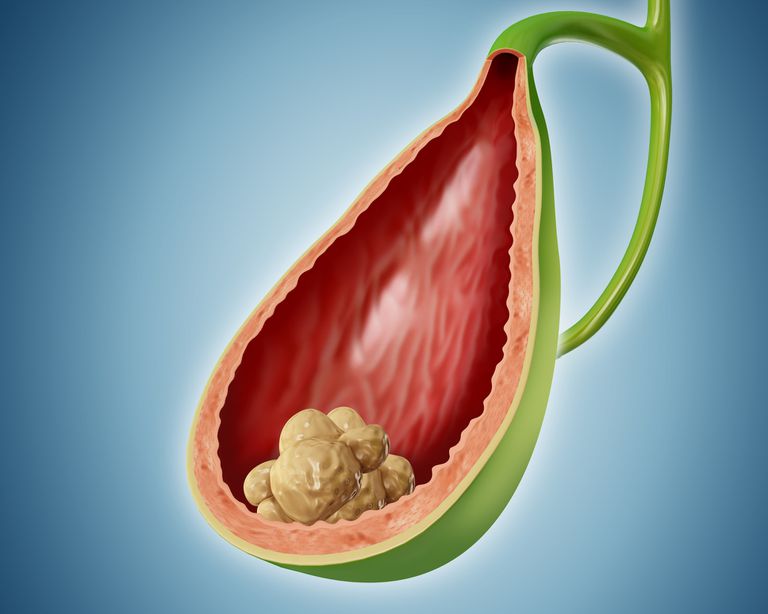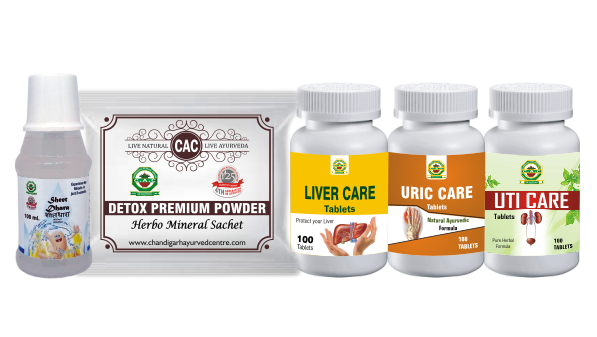
Gall Stones
- October 14, 2019
- Posted by Dr. Vaidya Karanvir Singh
- 0 Comment(s)
The Gallbladder is a very small organ that lies underneath the surface of the liver. Bile is secreted by the liver and stored in gallbladder. Then gall bladder contracts due to which bile is released into the intestine. When the gall bladder contracts it increases the number of hormone levels. Some of the chemicals exist in the gall bladder can solidify into either one large stone in gall bladder or several small ones.
Gall stones are also known as Cholelithiasis. It is commonly referred to the condition where the stones are either in the gallbladder or in common bile duct. Stone can block the normal flow of bile if they lodge in any of the ducts that carries bile from liver to the small intestine. That may include, hepatic duct, cystic duct, common bile duct.
The age range for the cases was between 15-85 years. The majority of the patients were in the range of 31 to 60 years. In India, the prevalence of gallstones ranges from 6% to 9% in the adult population. Age, Gender, Ethnicity diet and sedentary lifestyles influence the prevalence of gallstone.
What are the Causes of Gallstones?
There are some specific causes gallstones that have been known to be the culprit behind those –
- Presence of Excess Cholesterol can cause Gallstones.
- Due to excessive Bilirubin excretion.
- Gallstones caused due to the Obstruction of Bile duct.
How many types of gallstone?
Major types of gallstones are as follow –
- Cholesterol gallstones – They are composed mainly of cholesterol which is made in the liver and the most common kind which is approx. of 80% and is usually in yellow-green color.
- Pigment gallstones – These gallstones are composed of calcium salts, bilirubin and other materials. Color is usually dark brown or black color gallstones.
- Mixed stones – They are basically cholesterol stones which have been acted upon by the body’s bacteria and immune cells to break down the bilirubin. This causes a disturbance in the chemical composition of the stones where they begin to resemble that of pigment stones to some extent.
What are the Risk factors of Gallstones?
- Gender – Females are at more risk of developing gallstones.
- Weight – Obese people are at higher risk for developing this disease.
- Hormonal Changes – Pregnant women are also at risk for developing the gallstones due to estrogen hormone increases cholesterol concentration in blood and bile.
- Diet – Regular intake of a high-fat and high-cholesterol diet causes increased concentration of cholesterol in bile leading to gallstone formation.
- Having a family history of gallstone.
- High cholesterol level.
- Medications – Proton Pump Inhibitor decreases contraction ability of gallbladder which causes increased concentration of cholesterol, bilirubin, and calcium carbonate.
- Estrogen or birth control pills increases cholesterol concentration in blood and bile which causes gallstone formation.
What are the Signs and Symptoms of Gallstone?
In few cases single or multiple gallstones does not cause any symptoms or signs for several years but if it goes on several years it shows following symptoms –
- Excruciating pain is felt at upper right part of abdomen, and is often referred between the shoulder blades.
- Obstruction of bile duct results in colic pain followed by nausea and vomiting.
- Infection of gallbladder also causes inflammation which result in fever and chills.
- Jaundice can also be a sign of gallstone.
- Swelling and Tenderness.
- Inflammation of pancreas can also occur.
- Upper abdomen will experience sudden and sharp pain.
- Digestive problems – bloating, indigestion, heartburn, etc.
What is an Ayurvedic view of Gallstone?
In Ayurveda, gallbladder is termed as ‘Pittashmari’. All the three doshas, Vata, Pitta and Kapha play a role in the formation of gallstone. Excessive increase of pitta (caused by hot, spicy food, high amount of alcohol, etc.) creates the basis for stone formation. Kapha aggravated by fatty, heavy foods mixes with pitta and produces a highly sticky mixture. Vata dries this mixture and mould it into a shape of stone.
What is an Ayurvedic Treatment of Gallstone?
Ayurvedic treatment for gallstone eliminates the need of surgery by assisting the body to expel the stones naturally. Treatment involves the use of highly effective stone dissolving herbal formulae along with herbs to cleanse the liver and restores its function.
Chandigarh Ayurved Centre facilitates you the best herbal treatment for chronic gall stones with the ‘Gall stone Remove Kit’, which is extremely useful in disintegration of the cholilithiasis in a natural way and also helps in reducing the symptoms related to the gall stone. This Kit has a total of 5 products – Sheetaprabha vati, Uerolex capsules, Uerolex syrup, Panchaguna churna, Sheet dhara.
ALL PRODUCTS DESCRIPTION IN DETAIL:
1. Detox Premium Powder:
These herbal sachets mainly detox the body and helps in proper metabolism of all the functions. These sachets have anti-inflammatory, antioxidant, and anti-bacterial, anti-fungal, and immune-modulator. The ingredients present in it are moti pishti, parwal pishti, shukta pishti, Giloy satv, kamdudha ras, Jahar Mohra, akik pishti, gandhak rasayan, sutshekhar ras, etc. These ingredients helps in blood purification, reduces burning sensation, weakness, and hot flashes in ulcerative colitis patients. It reduces the level of high uric acid in the body. The powder is very beneficial in relieving discomfort, numbness, muscle ache, and reduces swelling of the pelvic region.
Recommended Dosage: Take 1 tablet twice a day with normal water.
2. Liver Care tablets:
Liver care tablet helps in balancing Pitta dosha. These tablets stimulate the growth of new liver cells, promote functions of liver, and improve blood flow from the liver. It helps in the treatment of fatty liver, liver cirrhosis, Hepatitis, hepatomegaly, and obstructive Jaundice. CAC Liver Care Tablets contains Ingredients like Kalmegh (Andrographis paniculata), Kutaki (Picrorhiza kurroa), Bhumi amla (phyllanthus niruri), Giloy(Tinopora Cordifolia), Yavakshar( Hordeum vulgare), Imli Kshar( Tamarindus indica), Mukta Shukta pisti etc.
Recommended Dosage: Take 1 tablet twice a day.
3. Sheet Dhara Syrup:
Sheet Dhara Syrup is an herbal preparatory which neutralizes the excess stomach acid to relieve heartburn, burping, loss of appetite, indigestion, an upset stomach, etc. This syrup works differently from other acid reducers as it prevents the secretion of stomach acid in a natural way and helps to overcome nausea, vomiting, abdominal pain, heaviness, etc.
Recommended Dosage: Mix 1 teaspoonful in 30 ml of water and take early in the morning on an empty stomach
4. UTI Care Tablet:
UTI Care Tablets helps to treat Urinary tract infections along with the diseases related to kidney, ureters, urinary bladder, and urethra. This tablet contains pure herbal ingredients which are Yavakshar (Hordeum vulgare), kalmi Shora (Pottasium nitrate), Naushadar (Ammonium chloride), Swarna Gairik (Red ochre), etc. UTI Care Tablets are also beneficial in kidney stones, chronic kidney disease, renal colic, burning sensation or pain during micturition, Hypertension. This herbal tablet detoxifies the gallbladder & maintain natural functioning.
Recommended Dosage: Take 1 tablet twice a day with normal water.
5. Uric care tablet:
Uric care tablets help in balancing kapha doshas. It reduces Kapha doshas impacting high URIC ACID levels of the body and acts as a potent diuretic. It helps reduce the pain while passing urine and clear the obstruction of urine. Help detoxify kidneys. It is also used to treat cough, oedema, asthma and various kidney problems. It contains ingredients like gokhru, imali kshar, yavakshar, kalmi shora, nausadar, swarna gairik etc. This formulation posseses hypotensive, antimicrobial, aphrodiasic and diuretic properties.
Recommended dosage: Take 1 tablet twice daily.
What is the Panchakarma Treatment of Gallstone?
Only Ayurvedic treatment for gallstones will work for removing gallstones naturally. There is no need for panchakarma treatment so the ayurvedic medicines mentioned above is good for gallstones. Use the above treatment for one month & see effective results.
Healthy tips and Diet for Gallstone –
Dietary factors often play a significant role in the gallstone formation, following appropriate dietary regimen and lifestyle will help to overcome the symptoms of gallstone –
- Non-Veg, Fatty food, Junk foods, Sweets, Chocolates, Breads, Milk product like curd, butter, carbonated drinks, alcohol must be strictly restricted.
- Highly intake of Fruits and Vegetables those are high in Vitamin C and B content are known to facilitate gallbladder functions and results in a healthy gallbladder.
- Leafy greens and various other fruits and vegetables which have high amount of fiber content also helps in the prevention factor working against the formulation of gallstones.
- Avoid foods with high fat content, vegetable oils, peanut oil, processes foods, refined white foods like bread and pasta.
- Eat healthy fats, like fish oil and olive oil which help your gallbladder contract and empty on a regular basis.
- Fats can add stress to the gallbladder so it is important that proteins in the diet be as lean as possible.
- Exercising regularly helps in keeping your weight in check. Swimming and running are good for your heart and overall health.
- Increase the levels of calcium like, dark, leafy greens vegetables mainly broccoli, sardines.
- Alternative plants milk that are fortified with calcium, such as almond or flax milk are higher in healthful fats and lower in saturated fats.
- Yoga plays an important role in the condition of gallstones. Following some asanas are believed to be beneficial for people with gallstones – Bhujangasana, Dhanurasana, Pachimotasana, Sarvangasana, Shalabhasana etc.

Dr. Vaidya Karanvir Singh is the younger Vaidya in Chandigarh Ayurved & Panchakarma Centre. He is the fourth generation in his family who is practicing as a general consultant in Ayurved & Panchakarma treatment at Chandigarh. In his practice, he had treated more than 1 Lakh Plus patients worldwide.



